TokyoSkyscrapers in Tokyo2020-05, (C) Seiji YoshimotoRainbow Bridge and Tokyo2006-05, (C) Seiji Yoshimoto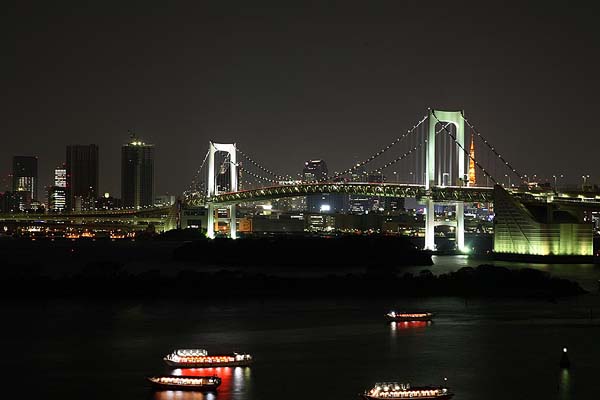  Shibuya, Tokyo2018-04, (C) Seiji Yoshimoto |
Tokyois the capital of Japan.
|
|||||||||||||||||||||||
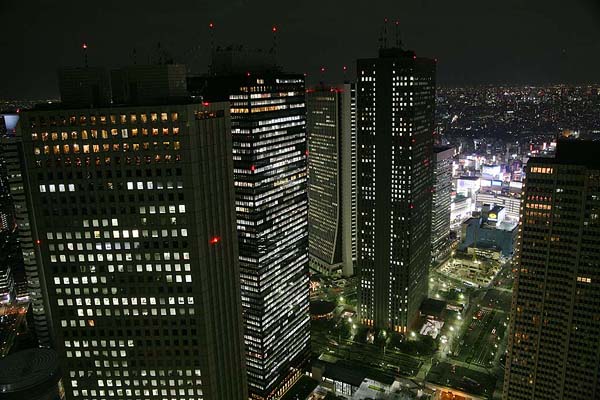 Shinjyuku Skyscrapers viewed from Metropolitan Government Building, Tokyo2006-04, (C) Seiji Yoshimoto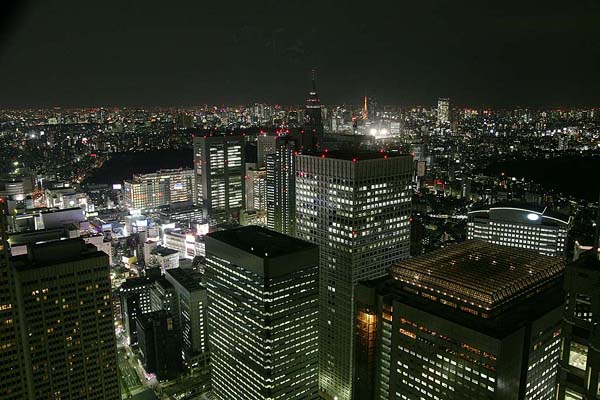  Shinjyuku Skyscrapers viewed from Metropolitan Government Building, Tokyo2006-04, (C) Seiji YoshimotoShinjyuku Skyscrapers viewed from Metropolitan Government Building, Tokyo2006-04, (C) Seiji YoshimotoTsukishima and Harumi Island viewed from Seiroka Tower, Tokyo2006-05, (C) Seiji YoshimotoKachidokibashi and Rainbow Bridge viewed from Seiroka Tower, Tokyo2006-05, (C) Seiji YoshimotoTsukiji viewed from Seiroka Tower, Tokyo2006-05, (C) Seiji Yoshimoto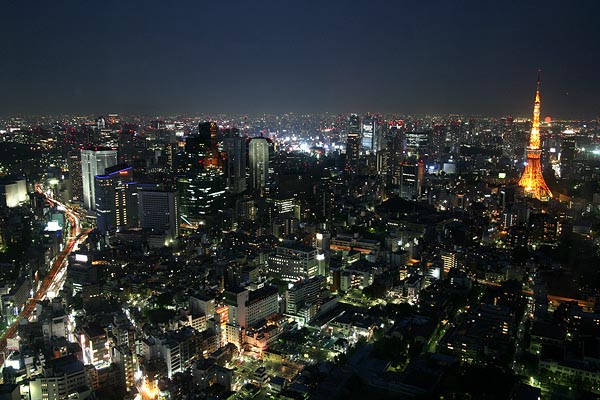 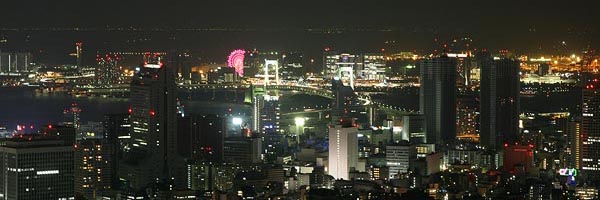 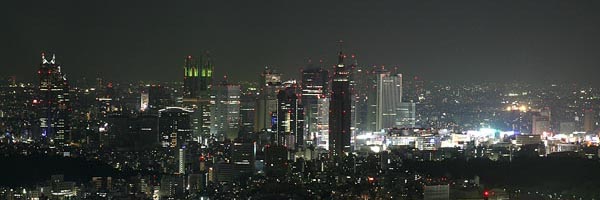 Shinjyuku Skyscrapers viewed from Roppongi Hills Tower, Tokyo2006-05, (C) Seiji YoshimotoCentral Tokyo viewed from Roppongi Hills Tower, Tokyo2006-05, (C) Seiji YoshimotoOdaiba viewed from Roppongi Hills Tower, Tokyo2006-05, (C) Seiji YoshimotoFrom Tokyo Metropolitan Government BuildingViews From Roppongi Hills Mori TowerViews From Seiroka Garden TowerView from Triton Square TowerHarumi viewed from Triton Square Tower, Tokyo2005-10, (C) Seiji Yoshimoto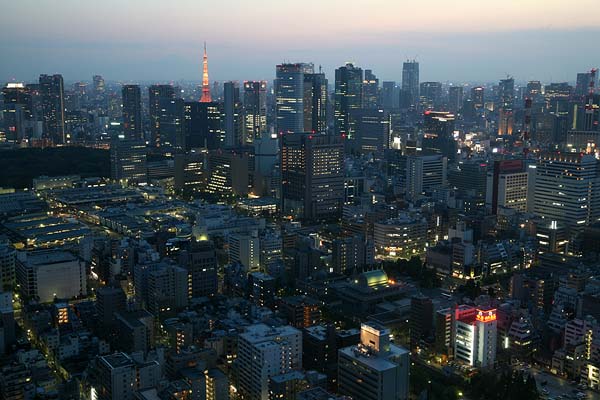 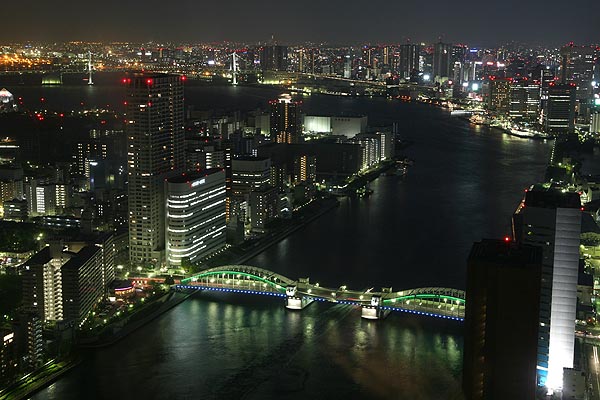  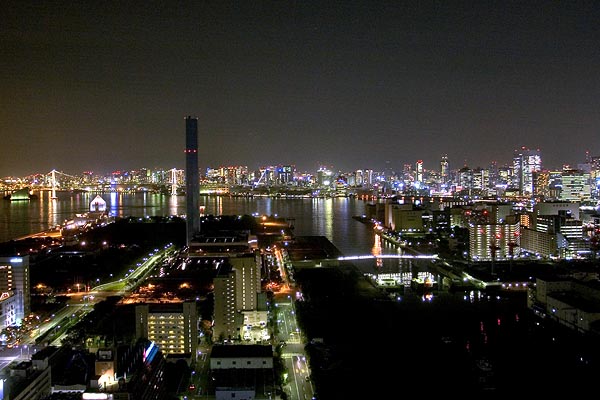 |
Night ViewsHuge megalopolis energy and urban activities of Tokyo can be viewed from several towers at night. Views From Tokyo Metropolitan Government BuildingTokyo metropolitan government building (Tokyo City Hall) is located in Shinjyuku, eastern center of Tokyo. It was built in 1991 and is 243m high. There are two observation rooms in the office open to public (free) and visitors can enjoy beautiful views of Skyscrapers in Shinjyuku.Views From Roppongi Hills Mori TowerRoppongi Hills is a newly redeveloped city completed in 2003. It has office spaces, in which leading financial, information technology venture companies are concentrated, residences, shops, restaurants, a cinema complex, a museum, and a hotel. Mori Tower is the central building of the Roppongi Hills. It is 250m high. There are many embassies in Roppongi. It is a unique area where foreigners gather.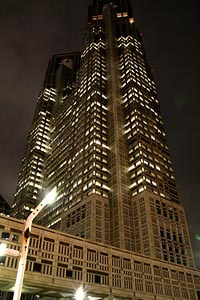  Metropolitan Government Building, Tokyo2006-04, (C) Seiji YoshimotoRoppongi Hills Mori Tower, Tokyo2006-05, (C) Seiji YoshimotoViews From Seiroka Garden TowerSeiroka Garden Tower is located near the Tsukiji Market just beside the Sumida River not far from the Tokyo Waterfront development. It is 221m high and has fantastic views of waterfront area.Metropolitan Govenment Building is a greenish twin tower on left center. Strong illuminations on right are entertainment areas such as Kabukityo.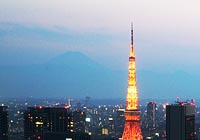 Mt. Fuji is seen just left side of Tokyo Tower.Mt. Fuji from Seiroka Tower, Tokyo2006-05, (C) Seiji Yoshimoto |
|||||||||||||||||||||||
 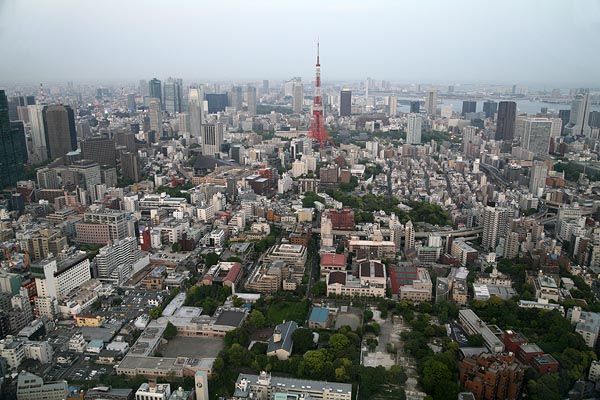  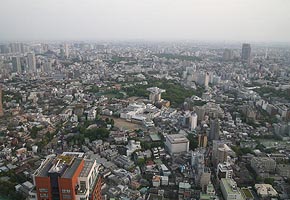 Kokyo and Kasumigaseki viewed from Roppongi Hills Tower, Tokyo2006-05, (C) Seiji YoshimotoShiodome and Tokyo Tower viewed from Roppongi Hills Tower, Tokyo2006-05, (C) Seiji YoshimotoOdaiba and Shinagawa viewed from Roppongi Hills Tower, Tokyo2006-05, (C) Seiji YoshimotoYokohama direction and Ebisu viewed from Roppongi Hills Tower, Tokyo2006-05, (C) Seiji YoshimotoShibuya viewed from Roppongi Hills Tower, Tokyo2006-05, (C) Seiji YoshimotoIkebukuro and Akasaka viewed from Roppongi Hills Tower, Tokyo2006-05, (C) Seiji YoshimotoShinjyuku viewed from Roppongi Hills Tower, Tokyo2006-05, (C) Seiji Yoshimoto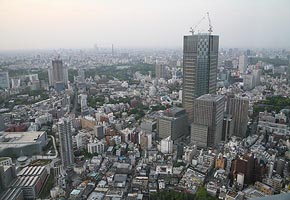  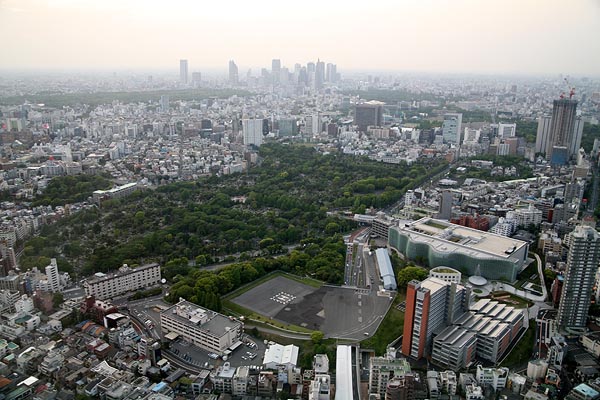 |
360 degree View of Tokyo from Roppongi Hills Mori TowerThe best place to see entire Tokyo, the largest megalopolis in the world, is an observation deck of Mori Tower located at about 250m above see level on Roppongi Hills. This Tower commands a most beautiful view of the entire city because it is close to the center of city and is not surrounded by skyscrapers of similar height.  The Landmark Tower (290m) amd other major buildings of Minatomirai 21 in Yokohama can be seen from Roppongi Hills Tower.Minatomirai 21 from Roppongi Hills2006-05, (C) Seiji Yoshimoto |
|||||||||||||||||||||||
Buildings around Imperial Palace, Tokyo2006-05, (C) Seiji YoshimotoBuildings around Imperial Palace, Tokyo2006-05, (C) Seiji Yoshimoto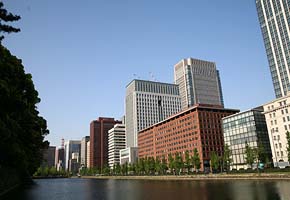  Buildings around Imperial Palace, Tokyo2006-05, (C) Seiji Yoshimoto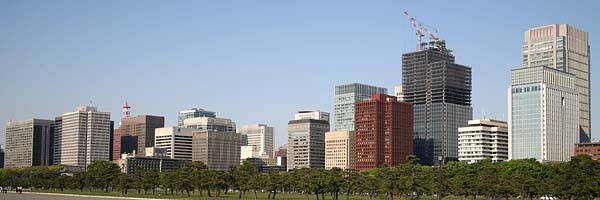 Buildings around Imperial Palace, Tokyo2006-05, (C) Seiji Yoshimoto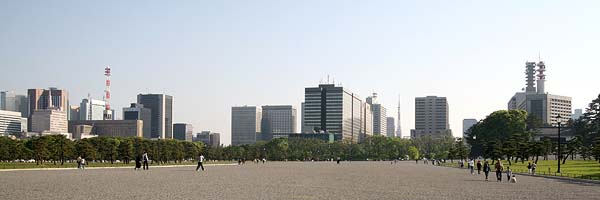 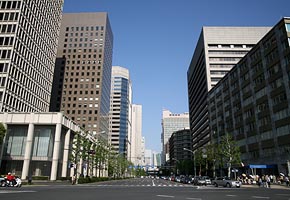 Buildings around Imperial Palace, Tokyo2006-05, (C) Seiji YoshimotoJapanese Garden in Kokyo (Imperial Palace), Tokyo2006-05, (C) Seiji Yoshimoto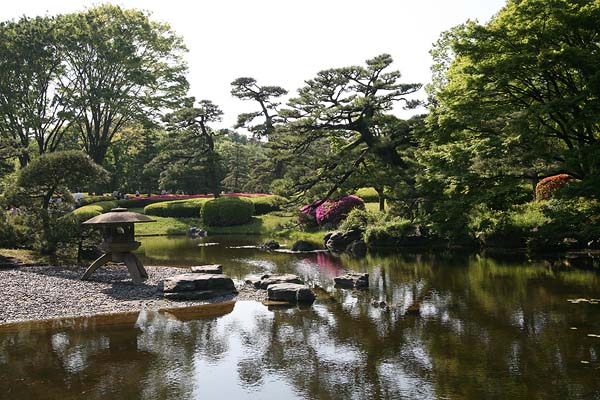 Nijyubashi Bridge of Kokyo (Imperial Palace), Tokyo2006-05, (C) Seiji Yoshimoto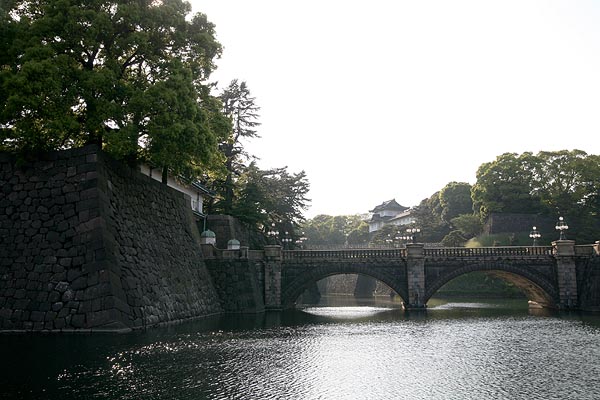 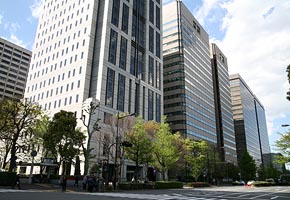 Buildings around Hibiya Park, Tokyo2006-04, (C) Seiji Yoshimoto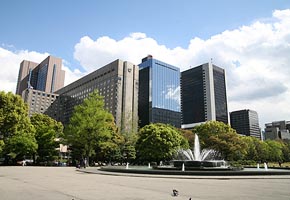 Buildings around Hibiya Park, Tokyo2006-04, (C) Seiji Yoshimoto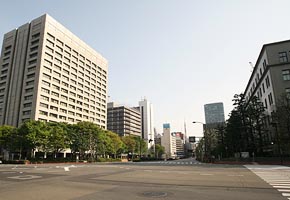 Government Ministries, Kasumigaseki, Tokyo2006-05, (C) Seiji YoshimotoGovernment Ministries, Kasumigaseki, Tokyo2006-05, (C) Seiji Yoshimoto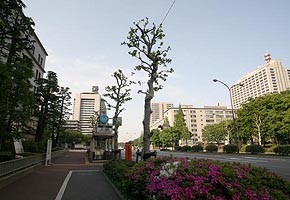 The Diet Building, Tokyo2006-12, (C) Seiji Yoshimoto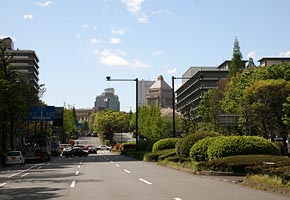 Government Ministries, Kasumigaseki, Tokyo2006-04, (C) Seiji Yoshimoto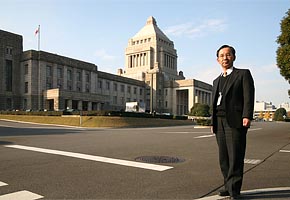 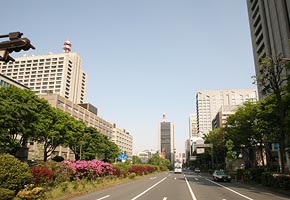 Government Ministries, Kasumigaseki, Tokyo2006-05, (C) Seiji Yoshimoto |
Imperial PalaceThe Kokyo (Imperial Palace, the residence of Japan's Imperial Family) is located on the former Edo Castle, a huge area surrounded by moats and massive stone walls in the center of Tokyo. The Nijyubashi (two bridges) is an entrance to the inner palace. The eastern area of the Palace are gardens often open to the public. Prestigious Business DistrictThere is a large plaza in front of the Imperial Palace called Kokyo Gaien. Around the Kokyo Gaien is Japan's most prestigious business district. There are headquarters or Tokyo branches of many of Japan's largest companies. KasumigasekiKasumigaseki is the center of national administration and politics of Japan. Almost all ministries are located in this area. The Diet Building, Prime Minister's official residence are located in Nagatacho, west of Kasumigaseki. |
|||||||||||||||||||||||
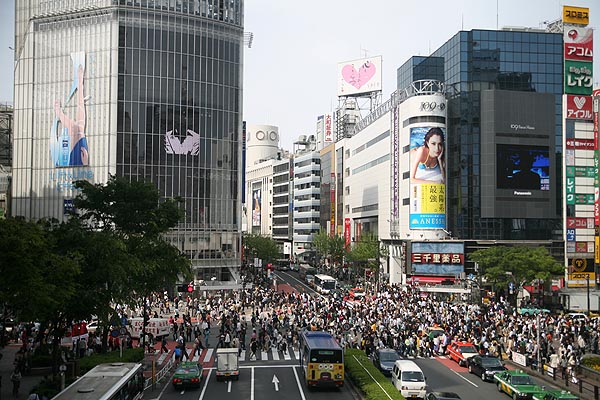 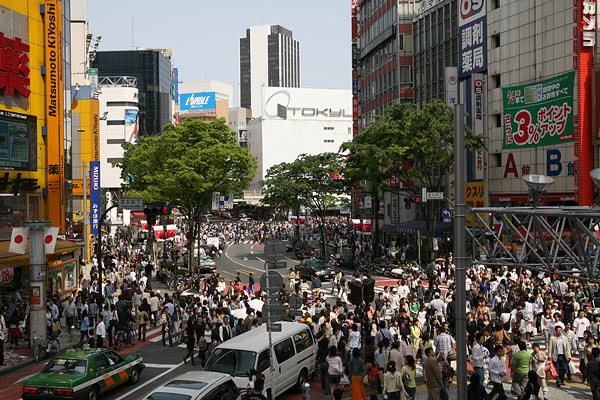 Shibuya, Tokyo2006-05, (C) Seiji YoshimotoShibuya, Tokyo2006-05, (C) Seiji YoshimotoShibuyaThe GinzaThe Ginza, Tokyo2006-12, (C) Seiji Yoshimoto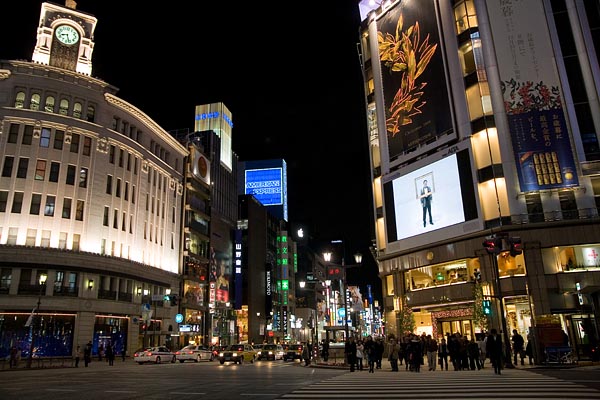   The Ginza, Tokyo2009-12, (C) Seiji YoshimotoThe Ginza, Tokyo2009-12, (C) Seiji Yoshimoto  The Ginza and Yurakucho, Tokyo2009-12, (C) Seiji Yoshimoto   The Ginza, Tokyo2009-12, (C) Seiji YoshimotoThe Ginza, Tokyo2009-12, (C) Seiji Yoshimoto The Ginza, Tokyo2009-12, (C) Seiji YoshimotoThe Ginza, Tokyo2009-12, (C) Seiji YoshimotoThe Ginza and Yurakucho, Tokyo2009-12, (C) Seiji Yoshimoto The Ginza and Yurakucho, Tokyo2009-12, (C) Seiji YoshimotoShinjyuku, Tokyo2007-012, (C) Seiji Yoshimoto ShinjyukuShinjyuku, Tokyo2006-05, (C) Seiji YoshimotoYasukunidori, Shinjyuku, Tokyo2006-05, (C) Seiji YoshimotoKabukicho, Shinjyuku, Tokyo2006-05, (C) Seiji Yoshimoto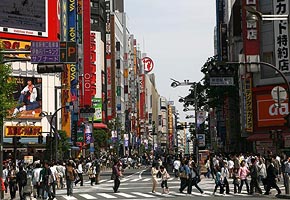  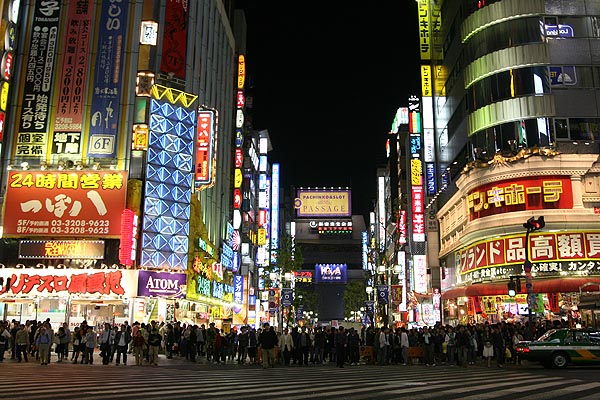  Shibuya, Tokyo2018-04, (C) Seiji Yoshimoto Shibuya, Tokyo2018-04, (C) Seiji Yoshimoto Shibuya, Tokyo2018-04, (C) Seiji Yoshimoto Shibuya, Tokyo2018-04, (C) Seiji YoshimotoShibuya, Tokyo2018-04, (C) Seiji YoshimotoShibuya, Tokyo2018-04, (C) Seiji YoshimotoShibuya, Tokyo2018-04, (C) Seiji Yoshimoto   |
Commercial and Entertainment DistrictsGinza, Shinjyuku, and Shibuya are famous shopping and amusement areas in Tokyo. There are many shops, restaurants, cinema complexes, etc. Numerous neon signs illuminate all-night entertainment areas. The GinzaNight clubs in the Ginza are very expensive and often used for business entertainment. Many taxies are waiting for good customers to go long distance to home late at night.ShinjyukuShinjyuku is the commercial and administrative center of Tokyo with heavy concentration of people, department stores, shops, cinemas, hotels, etc. Shinjyuku station is said to be the busiest station in the world and over 500,000 people use this station everyday. There is a town called Kabuki-cho, which never sleeps, well known for adult entertainment.ShibuyaShibuya is a commercial and entertainment district with several famous fashion department stores near Shibuya Station. Shibuya is always crowded with teenagers day and night . The intersection crossing in front of Shibuya Station uses a four-way stop to allow pedestrians to pass the entire intersection. |
|||||||||||||||||||||||
 Akihabara, Tokyo2007-12, (C) Seiji YoshimotoAkihabara, Tokyo2007-12, (C) Seiji YoshimotoAkihabara, Tokyo2007-12, (C) Seiji YoshimotoAkihabara, Tokyo2007-12, (C) Seiji Yoshimoto    Akihabara, Tokyo2007-12, (C) Seiji Yoshimoto        Akihabara, Tokyo2009-11, (C) Seiji YoshimotoAkihabara, Tokyo2007-12, (C) Seiji YoshimotoAkihabara, Tokyo2007-12, (C) Seiji YoshimotoAkihabara, Tokyo2007-12, (C) Seiji YoshimotoAkihabara, Tokyo2009-11, (C) Seiji YoshimotoAkihabara, Tokyo2007-12, (C) Seiji YoshimotoAkihabara, Tokyo2007-12, (C) Seiji YoshimotoAkihabara, Tokyo2009-11, (C) Seiji Yoshimoto |
Akihabarais huge shopping area with thousands of shops selling every electrical gadget from computers to video games, electronic parts, DVDs, anime, manga and figures. It is a place that gathers fanatics (called Otaku) of those themes. |
|||||||||||||||||||||||
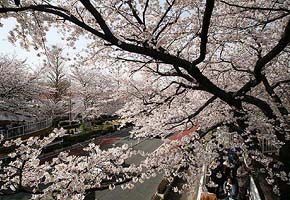 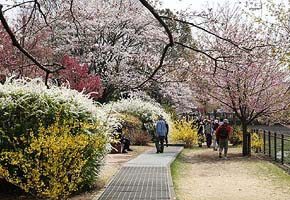 Kunitachi, Tokyo2006-04, (C) Seiji Yoshimoto 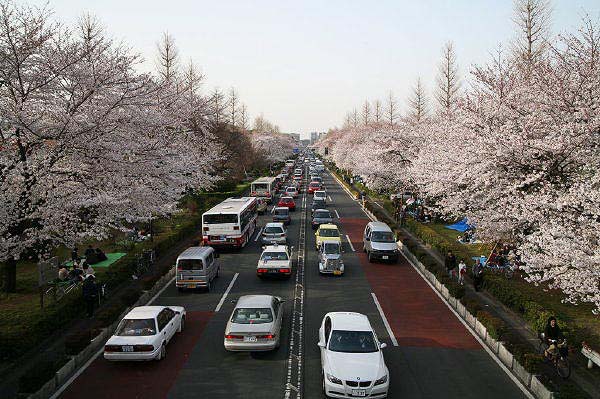 Kunitachi, Tokyo2006-04, (C) Seiji Yoshimoto    After Sakura, Showakinen Park, Tokyo2009-04, (C) Seiji YoshimotoAfter Sakura, Showakinen Park, Tokyo2009-04, (C) Seiji YoshimotoAfter Sakura, Showakinen Park, Tokyo2009-04, (C) Seiji YoshimotoSpring in Tokyo: After Sakura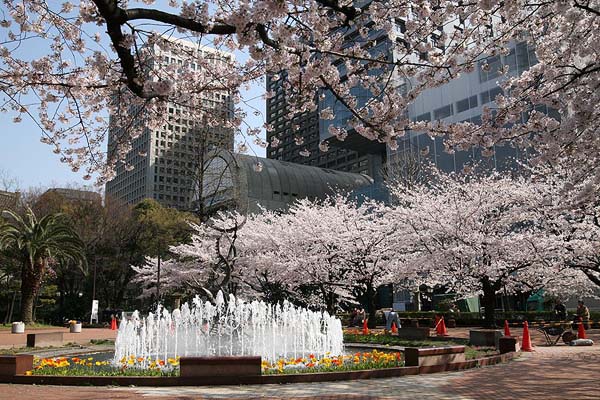 Hibiya Park, Tokyo2006-04, (C) Seiji Yoshimoto Shinjyuku, Tokyo2008-03, (C) Seiji Yoshimoto Ueno Park, Tokyo2008-03 (C) Seiji YoshimotoRikugien Garden, Tokyo2008-03 (C) Seiji Yoshimoto     Chidorigafuchi, Tokyo2012-04, (C) Seiji YoshimotoChidorigafuchi, Tokyo2012-04, (C) Seiji YoshimotoChidorigafuchi, Tokyo2012-04, (C) Seiji Yoshimoto |
SakuraSakura is one of Japanese national flowers and can be seen all over Japan. Sakura in full bloom are breathtaking, and people enjoy the spring under the beautiful Sakura trees. Sakura in full bloom last very short (less than a week) and Sakura blossoms fall like confetti shower. After SakuraOther different flowers and new green leaves start to decorate the city. Showakinen ParkShowakinen Park is located west of Tokyo built as a memorial park of the Showa Emperor. (This park is near the Head Office of NPO InterCoS.)
|
|||||||||||||||||||||||
Hanabi Festival, Showakinen Park, Tokyo2009-07, (C) Seiji Yoshimoto Hanabi Festival, Showakinen Park, Tokyo2009-07, (C) Seiji Yoshimoto Hanabi Festival, Showakinen Park, Tokyo2009-07, (C) Seiji Yoshimoto      Hanabi Festival, Hachioji, Tokyo2009-08, (C) Seiji YoshimotoHanabi Festival, Hachioji, Tokyo2009-08, (C) Seiji YoshimotoHanabi Festival, Hachioji, Tokyo2009-08, (C) Seiji YoshimotoHanabi Festival, Hachioji, Tokyo2009-08, (C) Seiji Yoshimoto |
SummerSummer in Tokyo is hot and humid. There are not very many beautiful flowers in this season. Instead, people enjoy a display of giant hanabi fireworks exploding in the night sky. Each starburst has a few hundred meter diameter and lasts just about 10 seconds. Tens of thousands of hanabi fireworks are launched in a short time period of one or two hours in one festival. Hanabi fireworks are the symbol of Japnese summer. Hundreds hanabi festivals are held in Japan.Japanese hanabi fireworks are known to be most gorgeous and elaborate in the world. They are famous for their perfect roundness and harmoniously blended, multicolored layers that blossom out into the night sky. |
|||||||||||||||||||||||
 Summer Festival, Hachioji, Tokyo2009-08, (C) Seiji Yoshimoto Summer Festival, Hachioji, Tokyo2009-08, (C) Seiji YoshimotoSummer Festival, Hachioji, Tokyo2009-08, (C) Seiji Yoshimoto   Summer Festival, Hachioji, Tokyo2009-08, (C) Seiji YoshimotoSummer Festival, Hachioji, Tokyo2009-08, (C) Seiji Yoshimoto |
||||||||||||||||||||||||
Hibiya Park, Tokyo2006-12, (C) Seiji Yoshimoto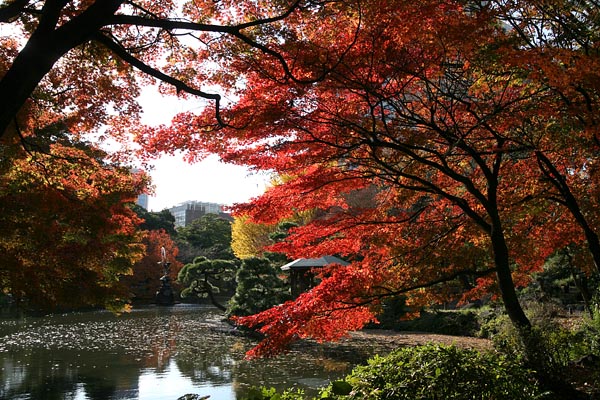  Rikugien Garden, Tokyo2006-12, (C) Seiji YoshimotoUeno Park, Tokyo2007-12, (C) Seiji Yoshimoto Ginko trees around the Diet Building (MEXT Building under Construction), Tokyo2006-12, (C) Seiji Yoshimoto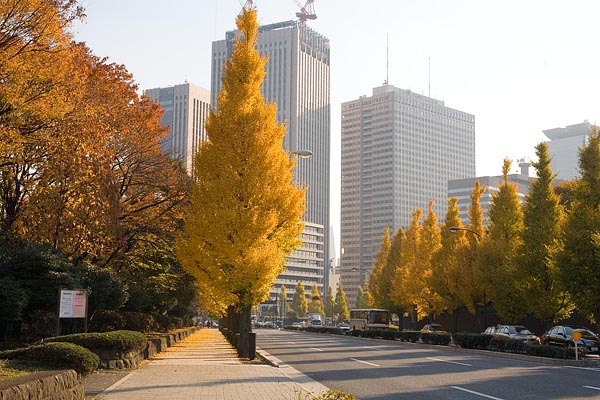 The Diet Building, Tokyo2006-12, (C) Seiji Yoshimoto   The University of Tokyo2011-12 , (C) Seiji YoshimotoSyowakinen Park2020-11 , (C) Seiji Yoshimoto  Syowakinen Park2020-11 , (C) Seiji Yoshimoto |
AutumnBeautiful momiji (red and yellow leaves) in autumn can be seen in several parks and gardens even in Tokyo. |
|||||||||||||||||||||||
Showakinen Park, Tokyo2006-12 (C) Seiji Yoshimoto Showakinen Park, Tokyo2006-12 (C) Seiji YoshimotoShowakinen Park, Tokyo2006-12 (C) Seiji Yoshimoto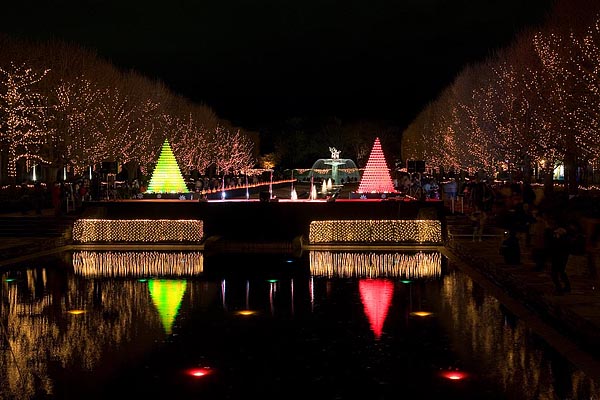 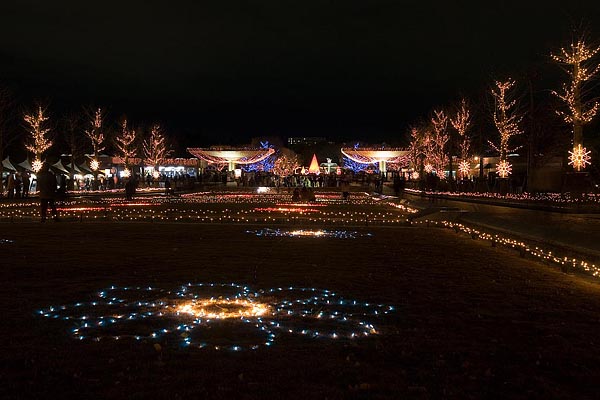  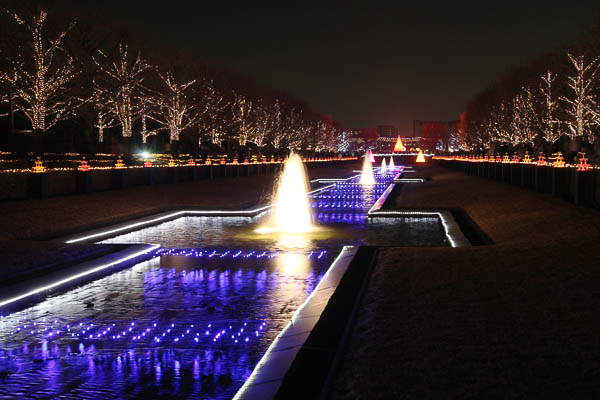 Showakinen Park, Tokyo2010-12 (C) Seiji YoshimotoShowakinen Park, Tokyo2010-12 (C) Seiji YoshimotoKeyakizaka, Roppongi hills, Tokyo2010-12 (C) Seiji YoshimotoKeyakizaka, Roppongi hills, Tokyo2006-12 (C) Seiji YoshimotoKeyakizaka, Roppongi hills, Tokyo2007-12 (C) Seiji Yoshimoto    Keyakizaka, Roppongi hills, Tokyo2010-12 (C) Seiji Yoshimoto Keyakizaka, Roppongi hills, Tokyo2010-12 (C) Seiji Yoshimoto Tokyo Mid Town2010-12 (C) Seiji YoshimotoTokyo Mid Town2010-12 (C) Seiji YoshimotoTokyo Mid Town, Roppongi, Tokyo2010-12 (C) Seiji Yoshimoto   Tokyo Mid Town, Roppongi, Tokyo2010-12 (C) Seiji Yoshimoto   Tokyo Dome City (Korakuen)2010-12 (C) Seiji YoshimotoTokyo Dome City (Korakuen)2010-12 (C) Seiji YoshimotoTokyo Dome City (Korakuen)2010-12 (C) Seiji Yoshimoto Tokyo Fantasia 2007, Hibiya Park2007-12 (C) Seiji YoshimotoBaccarat Eternal Lights, Yebisu Garden Place, Tokyo2007-12 (C) Seiji Yoshimoto  Hibiya Part, Yebisu Garden Place, and ShinjyukuShinjyuku, Tokyo2010-12 (C) Seiji Yoshimoto Odaiba, Tokyo2006-12 (C) Seiji YoshimotoOdaiba, Tokyo2007-12 (C) Seiji YoshimotoOdaiba, Tokyo2006-12 (C) Seiji Yoshimoto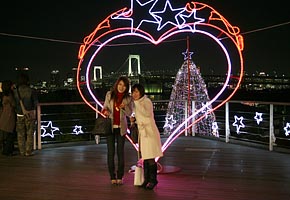 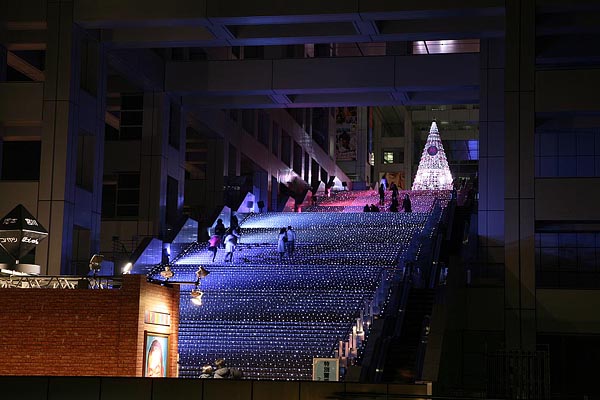  Rainbow Bridge, Odaiba, Tokyo2007-12 (C) Seiji YoshimotoOdaiba   The Ginza, Tokyo2009-12 (C) Seiji Yoshimoto The Ginza, Tokyo2009-12 (C) Seiji Yoshimoto The Ginza, Tokyo2006-12 (C) Seiji YoshimotoMarunouchi, Tokyo2006-12 (C) Seiji YoshimotoYurakucho, Tokyo2009-12 (C) Seiji Yoshimoto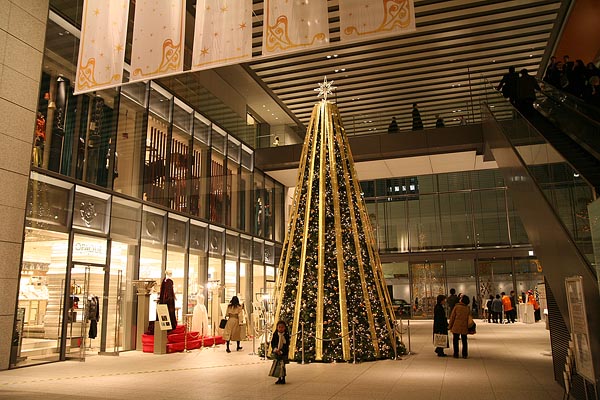 Marunouchi, Tokyo2006-12 (C) Seiji Yoshimoto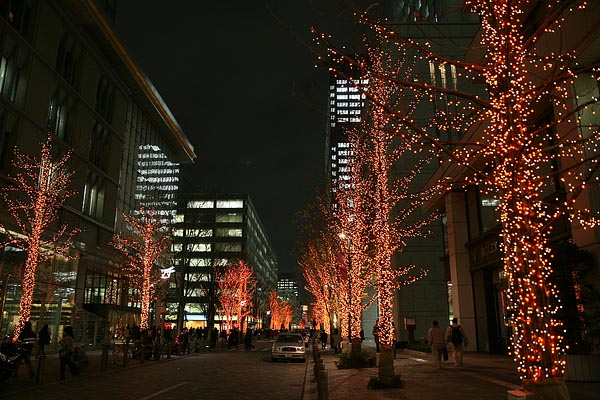  Marunouchi, Yurakucho Yurakucho, Tokyo2009-12 (C) Seiji YoshimotoShiodome, Tokyo2007-12 (C) Seiji Yoshimoto Shiodome, Tokyo2007-12 (C) Seiji Yoshimoto  Caretta Shiodome, Tokyo2007-12 (C) Seiji Yoshimoto Caretta Shiodome, Tokyo2009-12 (C) Seiji Yoshimoto |
Night in Tokyo is decorated fantastic in Christmas and New Year seasons with millions of LEDs.
Keyakizaka, around Roppongi hills is well known by its elegant illumination.Shiodome Shiositeis a new city developed in the east of Shinbashi. It consists of spectacular skyscrapers, shops, restaurants, theaters and hotels.
|
|||||||||||||||||||||||
Kaminarimon, Sensoji Temple, Tokyo2006-01, (C) Seiji Yoshimoto Sensoji Temple, Tokyo2008-01, (C) Seiji YoshimotoSensoji Temple, Tokyo2008-01, (C) Seiji Yoshimoto  Sensiji Temple 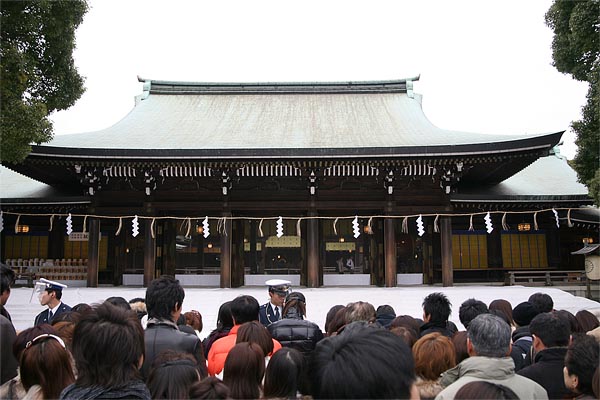 Meiji Shrine, Tokyo2007-01 (C) Seiji YoshimotoMeiji Shrine, Tokyo2010-01 (C) Seiji Yoshimoto Meiji Shrine, Tokyo2011-01 (C) Seiji YoshimotoFlower Arragement in Yasukuni Shrine, Tokyo2011-01 (C) Seiji Yoshimoto   Flower Arragement in Yasukuni Shrine, Tokyo2011-01 (C) Seiji YoshimotoYasukuni Shrine, Tokyo2009-01 (C) Seiji Yoshimoto This year's Tablet of Yasukuni Shrine, Tokyo2012-01 (C) Seiji Yoshimoto Zero Fighter in Yasukuni Shrine Museum, Tokyo2010-01 (C) Seiji Yoshimoto  Yasukuni Shrine, Tokyo2012-01 (C) Seiji Yoshimoto |
New Year's DayTokyo is a modern international city changing quickly, but, people keep traditions. As a new year's day's Japanese tradition, people pay visits to shrines (Shintoism) and temples (Buddhism) to pray to the Gods for the happy new year. Sensoji TempleAbout 2 million people pay visits to Sensoji Temple during the first 3 days of January. The Sensoji Temple and the Nakamise shopping street towards the temple is full of new year visitors. The street is only 340m, but it takes more than an hour to walk through it.Yasukuni ShrineDeities those who sacrificed themselves as the foundation stones for the making of modern Japan are worshipped at Yasukuni Shrine.
|
|||||||||||||||||||||||
|
||||||||||||||||||||||||

